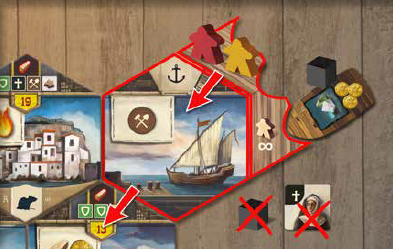Your turn
On your turn, you perform these steps in order:
-
Choose a hex and place one of your
lieutenant figures on it.
-
Rescue the citizen, if there is one,
and take the citizen to your estate.
-
Fight the plague.
-
Either perform the action depicted on the
hex, or repopulate the neighborhood.
|
|
Your efforts to fight the plague may give you
actions from the popularity register which
you can use any time during step 4.
|
|
|
Also at any time during step 4, you may pay
to advance on the city register or the church
register. You may advance multiple times in
one turn, if you wish. This may give you more
actions to use during step 4.
|
Other Types of Turns: Two other types of turns – (a) sending
a lieutenant to the docks or (b) recalling a lieutenant to your
estate – are explained here.
1. Choosing a Hex
|
|
In round I: Simply take your lieutenant figure from your estate
and stand it on a hex that does not yet have a figure on it.
Your figure marks the hex where you will work this turn, and
it blocks everyone (including you) from choosing that hex on
later turns this round.
|
|
|
In Rounds II–VI: You already have lieutenants in Messina, on
the hexes they occupied in the previous round. They begin the
new round lying down to show they have not been used and are
not blocking that hex.
When choosing a hex for a lying-down figure, you can choose
the same hex or an adjacent hex for free. But to choose a hex
farther away, you must pay 1 coin for each hex beyond the first.
For example, moving 4 hexes away would cost 3 coins.
|
|

|
First movement is
free. Second and
further costs one
coin for each hex.
|
You are not allowed to choose a hex marked by a standing-up
figure – that hex has already been used this round.
Stand your lieutenant figure in your chosen hex to show that
the lieutenant and the hex have been used. Each of your lieutenants
will be used exactly once during the round, and no hex
will be used more than once.
Additional lieutenants: You may acquire additional lieutenants
from the city register track (which will be explained here).
The new figure will start out on your estate. On your
turn, you may use that lieutenant only if all your lieutenants in
Messina have already been used this round.
Lieutenants coming from your estate are placed according the
rules used in round I – you can choose any hex in Messina not
occupied by a standing-up figure.
2. Rescuing a Citizen
If your chosen hex has a citizen token, you rescue that citizen
(citizens). Add the token to your estate, depending on whether
the hex has plague.
If the chosen hex has no plague cube, you place the citizen
on one of the empty squares in the sector that matches your
citizen’s class. (The top sector is for craftsmen, the left sector is
for aristocrats, and the right sector is for nuns.) There are six
squares in each sector; if none of these is empty, discard the
citizen token.
If the chosen hex has a plague cube, your citizen must go to
quarantine. Place the token in space I of any empty quarantine
cabin. If all cabins already have a citizen (in space I or II) you
must discard the new citizen.
Every cabin line can hold exactly
one citizen even if there is one of the two spaces free.
|
|
Red chooses a hex with a nun. The hex has no plague cube, so when
Red rescues the nun, she must place the nun in an empty square in
the gray sector of her estate. The chosen square will be important
later, but it does nothing at this time.
|
|
|
By contrast, if there is a plague cube on the hex, then the nun cannot
go to the gray sector and Red would have to put the nun in
space I of an empty quarantine cabin.
Note: A citizen from a plagued neighborhood must go to quarantine
even if you eliminate the plague in the next step of your turn.
|
3. Fighting Plague
Once the citizen is evacuated, you may be able to destroy the
plague in that neighborhood.
If the chosen hex has a plague cube, you may pay 1 fire token
to remove the plague cube. If it has multiple plague cubes you
may remove as many as you like, paying 1 fire token for each.

|
In later rounds, the cost to remove a plague
cube is 2 fire tokens, as shown on the round
info table. In this case, for each plague cube
removed, score 2 points.
|
After you spend fire tokens, if there are any plague cubes left on
your chosen hex, gain 1 rat for each plague cube. (The plague
cubes remain on the hex for later rounds.)
At the end of the game you will be penalized for your rat tokens. (See here).
|
For each plague cube you removed, advance 1 space on the
popularity register. If this leads to one or more actions (see
here)
you may resolve them before, after, or during your hex
action.
|
|
Fire Tokens

|
You start the game with no fire tokens, but
you can acquire them during play. Initially,
it costs 1 fire token for each plague cube you
remove from your lieutenant’s hex. Later in
the game, the cost rises to 2 fire tokens per
cube.
|

|
You could also acquire a major fire token.
When you use this to remove a plague cube
from the hex, you have the option to
remove
a cube from an adjacent hex as well.
|
Special Cases:
-
You can use a major fire token as a regular fire token
and ignore its ability to remove 1 adjacent cube.
-
The plague cube on a boat is not “adjacent” to any
hex, dock, or other boat, so if you use a major fire
token on a boat, you will not be able to remove an
additional cube.
-
If 2 fire tokens are required to remove 1 plague cube,
you need to spend 2 major fire tokens to have the option
of removing an adjacent cube.
4. Performing the Hex Action

|
Every hex has an action illustrated
in the upper left corner. You perform
that action as the last step of your
turn.
|

|
Most hexes can be repopulated with
citizens from your estate. If you
choose to repopulate the hex, you do
this instead of the illustrated action.
|
Also during this step of your turn, you may use any actions you
received from the popularity register and you may also pay to
advance on the other two registers, which could lead to even
more actions. These register actions may be resolved in any order
before, after, or even during your hex action.
The various actions will be explained on the following pages.
The registers are explained here in detail.
Other Types of Turns
There are two other ways to use your lieutenant’s turn.
Recalling a Lieutenant
On your turn, instead of sending your lieutenant to a hex or
a dock, you can recall it to your estate. Simply stand it beside your
board and gain 1 coin. The lieutenant cannot be used again until
the next round.
This is not a very efficient use of your lieutenant, but it gives you
a way to deal with situations where all the nearby hexes are blocked
and you cannot afford the cost of traveling to a farther hex.
Choosing a Boat
On your turn, you can send your lieutenant to choose a boat
instead of a hex. The steps are similar to a regular turn:
-
Choose a boat in Messina and move your lieutenant to its
dock, according to the usual movement rules. (Count the
dock as a separate hex adjacent to the harbor.)
-
You may even go to a dock that has already been visited by
another lieutenant this round.
-
Fight the boat's plague cube, or gain 1 rat token if you
choose not to fight it. (Either way, the plague cube is discarded.)
-
Take the boat tile to your estate. Gain coins or score points,
as indicated on the boat tile.

|
After taking the tile, if you now have
an even number of boats, you may advance
one of your overseers. Overseers
are explained here.
|

|
Also during this step, you may buy advances
on the city and church registers
and use any register actions you have
earned, in any order, as usual.
|
The goods on the boat tile will have an impact during final
scoring. In the standard game, all types of goods will count the
same. In the advanced variant, you are trying to collect goods
of one type. (See here.)

|
The three types
of goods are
precious stones,
spices and silk.
|
Docks versus Hexes

|
Docks are like hexes with these differences:
-
The dock does not get plague cubes; instead, each
boat comes with its own plague cube.
- The dock, like a harbor hex, does not get citizens.
-
A lieutenant at a dock does not block other lieutenants
from using that dock. Instead, lieutenants are
limited by the availability of the boats.
When moving a lieutenant, the dock counts as its own
hex, adjacent only to its harbor hex. So every neighborhood
adjacent to the harbor hex is 2 hexes away from
the dock.
|